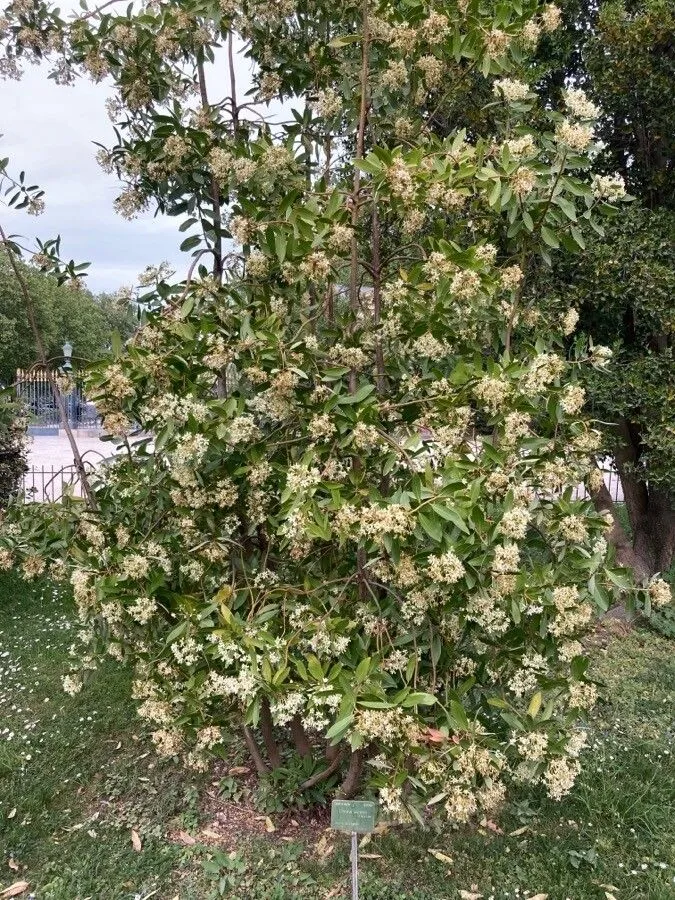
Author: J.R.Forst. & G.Forst.
Bibliography: Char. Gen. Pl.: 84 (1776)
Year: 1776
Status: accepted
Rank: species
Genus: Drimys
Vegetable: False
Observations: S. Chile to SW. Argentina
Winter’s bark, known scientifically as Drimys winteri, is an intriguing and lesser-known plant species native to the southern regions of Chile and southwestern Argentina. Belonging to the Winteraceae family, this plant offers both historical and botanical significance.
This robust evergreen tree typically thrives in cool, temperate rainforests where the climate is moist, contributing to its lush growth. Drimys winteri can reach impressive heights, often growing up to 20 meters tall, with a trunk diameter that reflects its mature, resilient nature. The bark is one of its most distinctive features, sporting a reddish-brown to dark brown hue that peels away in thin flakes, providing an appealing textural quality.
The leaves of Winter’s bark are another highlight, with their glossy, dark green appearance and a leathery texture that supports the tree’s adaptability in its native habitat. They are simple, alternate, and lanceolate, sometimes showcasing a striking aromatic quality when crushed, which hints at their underlying essence and potential medicinal properties.
Winter’s bark also produces small, yet visually captivating flowers. These typically bloom in late winter to early spring, providing a refreshing splash of white against the evergreen foliage. The flowers have a delicate yet distinctive aroma, attracting various pollinators essential for the plant’s reproduction cycle. Post pollination, these flowers give way to small, berry-like fruits that encapsulate the lifecycle of this notable plant.
The historical significance of Drimys winteri is deeply rooted in its use during the expeditions of the 18th century. The plant’s namesake, Captain John Winter, a close companion of Sir Francis Drake, discovered its potent properties. The bark was famously utilized as a remedy for scurvy, a prevalent disease among sailors due to vitamin C deficiency, underscoring its long-standing medicinal use.
In contemporary settings, the bark and leaves of Drimys winteri continue to be explored for their potential health benefits. Traditional uses in native cultures have highlighted its roles in treating ailments like rheumatism and stomach issues, further cementing its place in ethnobotanical studies.
Overall, the Winter’s bark is a fascinating species that represents an intersection of natural beauty, historical importance, and potential medicinal value. Its presence from southern Chile to southwestern Argentina underscores a plant well-adapted to its environment, resonating with both ecological and human narratives over centuries.
Spa: canelo
Eng: winter’s bark, winter’s-bark
Swe: pepparbarksträd
En: Winter’s bark, Winter’s-bark
Es: Canelo
Sv: Pepparbarksträd
Taken Jul 25, 2022 by Angela Esquivel Angela Esquivel (cc-by-sa)
Taken Jul 25, 2022 by Angela Esquivel Angela Esquivel (cc-by-sa)
Taken Aug 21, 2021 by González analia (cc-by-sa)
Taken Aug 19, 2022 by Piña Alvaro (cc-by-sa)
Taken Apr 7, 2020 by Diego Alex (cc-by-sa)
Taken Apr 28, 2022 by Alexis de Courson (cc-by-sa)
Taken Sep 30, 2022 by FUENTES LUIS (cc-by-sa)
Taken Mar 20, 2022 by Serge Klein (cc-by-sa)
Taken May 7, 2022 by Bernadette Pignot (cc-by-sa)
Taken Jul 16, 2022 by Stefano Cuvili (cc-by-sa)
Taken Jan 3, 2016 by Daniel Barthelemy (cc-by-nc)
Taken Jan 3, 2016 by Daniel Barthelemy (cc-by-nc)
Taken Jan 3, 2016 by Daniel Barthelemy (cc-by-nc)
Taken Jan 4, 2016 by Daniel Barthelemy (cc-by-nc)
Taken Jan 4, 2016 by Daniel Barthelemy (cc-by-nc)
© copyright of the Board of Trustees of the Royal Botanic Gardens, Kew.
© copyright of the Board of Trustees of the Royal Botanic Gardens, Kew.
© copyright of the Board of Trustees of the Royal Botanic Gardens, Kew.
Taken Apr 26, 2022 by William Coville (cc-by-sa)
Taken Apr 19, 2022 by Fero Looxi (cc-by-sa)
Taken Sep 30, 2022 by FUENTES LUIS (cc-by-sa)
Taken Mar 4, 2022 by Nicolás Pizarro (cc-by-sa)
Taken Jul 16, 2022 by Stefano Cuvili (cc-by-sa)
Taken Jan 1, 1997 by Daniel Barthelemy (cc-by-nc)
Taken Jan 1, 1997 by Daniel Barthelemy (cc-by-nc)
Taken Sep 20, 2021 by Pauli Sam (cc-by-sa)
Taken Jul 15, 2022 by Anatas (cc-by-sa)
Taken Jul 15, 2022 by Anatas (cc-by-sa)
Taken Aug 7, 2022 by Rowemk (cc-by-sa)
Taken Jul 25, 2022 by #MaryKingfishers MK (cc-by-sa)
Taken Oct 10, 2021 by Ignacio Arrigorriaga Nickel (cc-by-sa)
Family: Myrtaceae Author: (F.Muell.) K.D.Hill & L.A.S.Johnson Bibliography: Telopea 6: 402 (1995) Year: 1995 Status:…
Family: Rubiaceae Author: Pierre ex A.Froehner Bibliography: Notizbl. Bot. Gart. Berlin-Dahlem 1: 237 (1897) Year:…
Family: Sapindaceae Author: Koidz. Bibliography: J. Coll. Sci. Imp. Univ. Tokyo 32(1): 38 (1911) Year:…
Family: Asteraceae Author: A.Gray Bibliography: Pacif. Railr. Rep.: 107 (1857) Year: 1857 Status: accepted Rank:…
Family: Fabaceae Author: Medik. Bibliography: Vorles. Churpfälz. Phys.-Ökon. Ges. 2: 398 (1787) Year: 1787 Status:…
Family: Aspleniaceae Author: (Cav.) Alston Bibliography: Bull. Misc. Inform. Kew 1932: 309 (1932) Year: 1932…